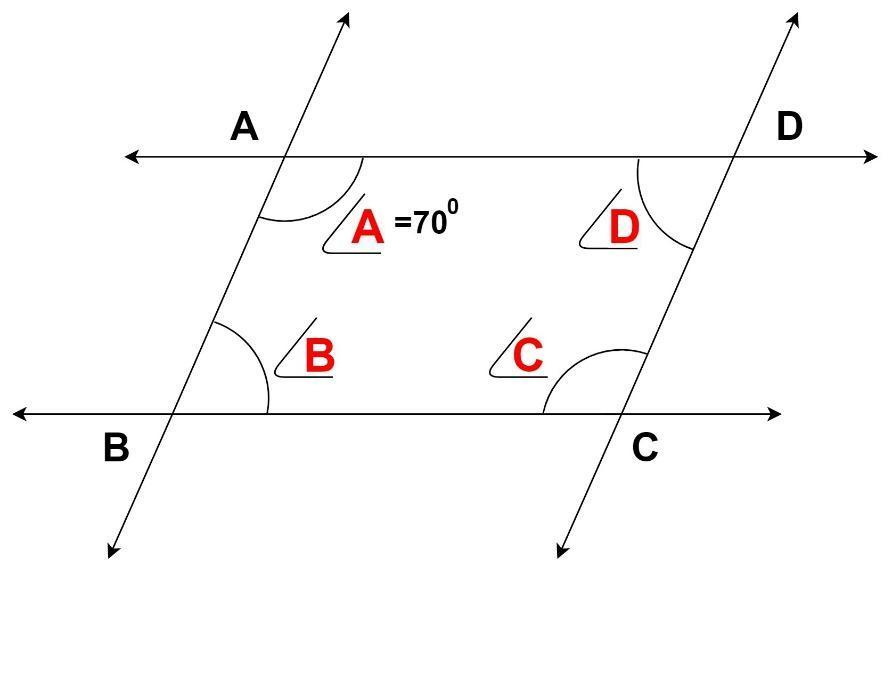
ABCD is a parallelogram in which angle $\angle A = {70^0}$ . Compute angle B,angle C and angle D.


Answer
609k+ views
Hint: Use geometrical theorems related to parallel lines.
Given in the problem ABCD is a parallelogram with angle $\angle A = {70^0}$.
We know that opposite sides of the parallelogram are parallel to each other.
$
\Rightarrow AB{\text{ is parallel to }}CD{\text{ (1)}} \\
\Rightarrow AD{\text{ is parallel to B}}C{\text{ (2)}} \\
$
Same side Interior angle theorem states that the interior angles formed by a transversal line intersecting two parallel lines are supplementary.
Using the same theorem in parallelogram $ABCD$, we get:
\[
(1) \Rightarrow {\text{ }}\angle A + \angle D = {180^0}{\text{ and }}\angle B + \angle C = {180^0} \\
(2) \Rightarrow {\text{ }}\angle A + \angle B = {180^0}{\text{ and }}\angle C + \angle D = {180^0} \\
\]
Using angle $\angle A = {70^0}$ in above equations, we get:
\[
{70^0} + \angle D = {180^0}{\text{ }} \\
\Rightarrow \angle D = {110^0} \\
{70^0} + \angle B = {180^0} \\
\Rightarrow \angle B = {110^0} \\
\angle B + \angle C = {180^0} \\
\Rightarrow \angle C = {70^0} \\
\]
Hence\[{\text{ }}\angle B = {110^0}{\text{ , }}\angle C = {70^0}{\text{ , }}\angle D = {110^0}\] .
Note: The same side interior angle theorem is only valid for parallel lines. Geometric properties of parallelogram and parallel lines should be kept in mind while solving problems like this.
Given in the problem ABCD is a parallelogram with angle $\angle A = {70^0}$.
We know that opposite sides of the parallelogram are parallel to each other.
$
\Rightarrow AB{\text{ is parallel to }}CD{\text{ (1)}} \\
\Rightarrow AD{\text{ is parallel to B}}C{\text{ (2)}} \\
$
Same side Interior angle theorem states that the interior angles formed by a transversal line intersecting two parallel lines are supplementary.
Using the same theorem in parallelogram $ABCD$, we get:
\[
(1) \Rightarrow {\text{ }}\angle A + \angle D = {180^0}{\text{ and }}\angle B + \angle C = {180^0} \\
(2) \Rightarrow {\text{ }}\angle A + \angle B = {180^0}{\text{ and }}\angle C + \angle D = {180^0} \\
\]
Using angle $\angle A = {70^0}$ in above equations, we get:
\[
{70^0} + \angle D = {180^0}{\text{ }} \\
\Rightarrow \angle D = {110^0} \\
{70^0} + \angle B = {180^0} \\
\Rightarrow \angle B = {110^0} \\
\angle B + \angle C = {180^0} \\
\Rightarrow \angle C = {70^0} \\
\]
Hence\[{\text{ }}\angle B = {110^0}{\text{ , }}\angle C = {70^0}{\text{ , }}\angle D = {110^0}\] .
Note: The same side interior angle theorem is only valid for parallel lines. Geometric properties of parallelogram and parallel lines should be kept in mind while solving problems like this.
Recently Updated Pages
Two men on either side of the cliff 90m height observe class 10 maths CBSE

What happens to glucose which enters nephron along class 10 biology CBSE

Cutting of the Chinese melon means A The business and class 10 social science CBSE

Write a dialogue with at least ten utterances between class 10 english CBSE

Show an aquatic food chain using the following organisms class 10 biology CBSE

A circle is inscribed in an equilateral triangle and class 10 maths CBSE

Trending doubts
Why is there a time difference of about 5 hours between class 10 social science CBSE

Write a letter to the principal requesting him to grant class 10 english CBSE

What is the median of the first 10 natural numbers class 10 maths CBSE

The Equation xxx + 2 is Satisfied when x is Equal to Class 10 Maths

Which of the following does not have a fundamental class 10 physics CBSE

State and prove converse of BPT Basic Proportionality class 10 maths CBSE




